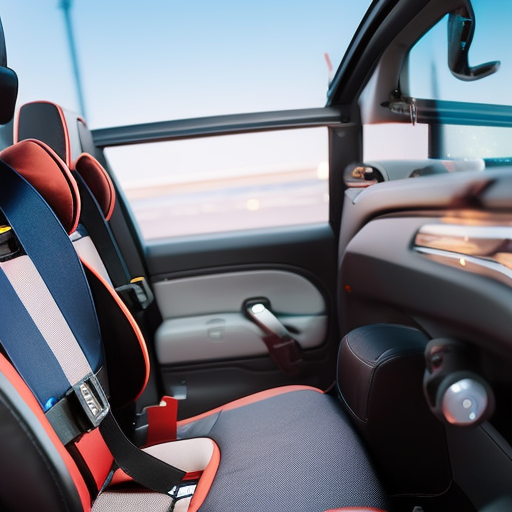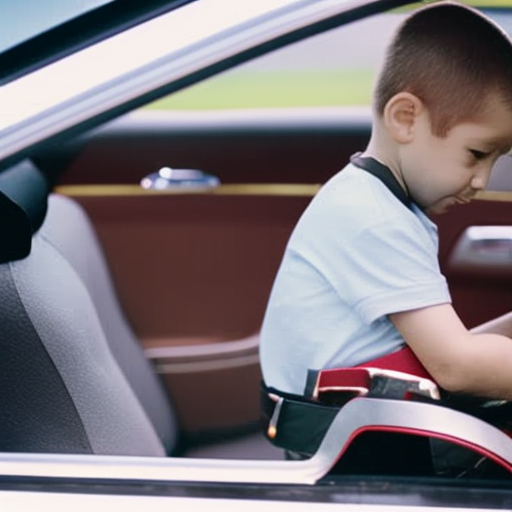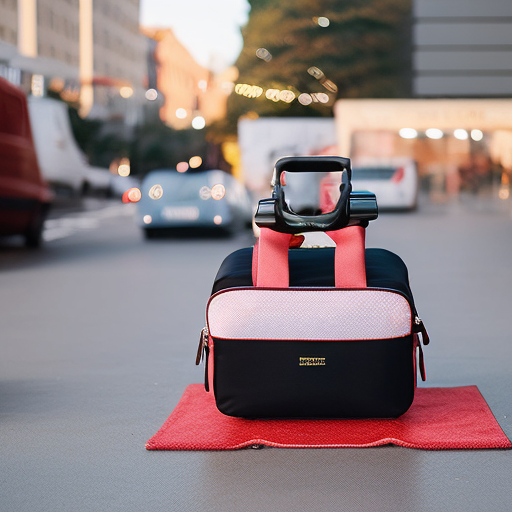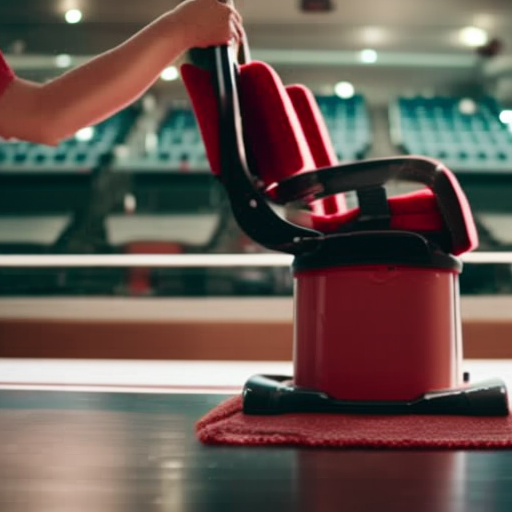"Cherishing Little Steps - A Haven for Baby and Family Journeys"
Choosing Booster Seats Wisely
When it comes to choosing booster seats wisely, remember the old saying: ‘Better safe than sorry.’ As a parent or caregiver, you want to ensure that your child is protected and comfortable during car rides. But with so many options available, how do you make the right choice?
This guide is here to help you navigate the important factors to consider when selecting a booster seat. From safety ratings and age requirements to adjustable features and customer reviews, we’ll cover it all.
By the end, you’ll feel confident in your decision, knowing that you’ve chosen a booster seat that not only meets safety standards but also suits your child’s needs. So let’s dive in and find the perfect booster seat for your little one!
Key Takeaways
- Look for booster seats with high safety ratings, as they provide information about protection in crashes and are tested and rated by reputable organizations.
- Check age and height requirements before purchasing a booster seat, and ensure it is suitable for your child’s age and height.
- Look for booster seats with adjustable features, such as adjustable headrests, armrests, and seat belt guides, for optimal comfort and support.
- Prioritize booster seats with user-friendly installation and maintenance instructions, and regularly clean and maintain the seat according to the manufacturer’s guidelines.
Safety Ratings

When choosing a booster seat, make sure to look for one that has high safety ratings. Safety ratings are an essential factor to consider when purchasing a booster seat for your child. These ratings provide valuable information about the seat’s ability to protect your child in the event of a crash. Look for booster seats that have been thoroughly tested and rated by reputable organizations such as the National Highway Traffic Safety Administration (NHTSA) or the Insurance Institute for Highway Safety (IIHS). These organizations evaluate a range of safety features, including the seat’s ability to withstand impact, the effectiveness of its restraint system, and its overall stability during a crash.
Crash test results are a crucial component of safety ratings. They indicate how well a booster seat performs in simulated crash scenarios. The higher the safety rating, the more confidence you can have in the seat’s ability to protect your child. Pay close attention to crash test results that evaluate both frontal and side impacts, as these are the most common types of collisions on the road.
Age and Height Requirements
Check the age and height requirements before purchasing a booster seat. It is important to ensure that the booster seat you choose is suitable for your child’s age and height to provide optimal safety and protection. Different booster seats have varying age and weight restrictions, so it’s essential to carefully read and follow the manufacturer’s guidelines. To help you better understand the age and height requirements, here is a table outlining the general recommendations for booster seat usage:
| Age Range | Height Range | Weight Range |
|---|---|---|
| 4-8 years | 40-57 inches | 40-80 pounds |
| 8-12 years | 57-62 inches | 80-100 pounds |
| 12+ years | >62 inches | >100 pounds |
Remember that these are just general guidelines, and it’s always best to consult the specific instructions provided by the booster seat manufacturer. Additionally, when installing the booster seat, make sure to follow the recommended installation methods to ensure proper positioning and secure attachment. By adhering to the age and height requirements and correctly installing the booster seat, you can greatly enhance your child’s safety while traveling in a vehicle.
Weight Limits
Make sure to consider the weight limits when selecting a booster seat for your child. The weight capacity of a booster seat is an important factor to consider for the safety and comfort of your child. Most booster seats have a weight limit ranging from 30 to 120 pounds. It’s crucial to choose a seat that can accommodate your child’s weight to ensure proper protection in the event of a crash.
In addition to weight capacity, you should also pay attention to any size restrictions that may be associated with the booster seat. Some seats have height limitations or specific dimensions that your child must meet in order to use the seat safely. It’s important to carefully read the manufacturer’s guidelines and specifications to ensure that your child meets all the necessary requirements.
Adjustable Features

Consider the versatility of adjustable features when selecting a booster seat for your child. These customization options not only provide comfort for your little one but also ensure their safety and longevity of use. Here are five key adjustable features to look for:
-
Adjustable headrest: A headrest that can be easily adjusted ensures proper head and neck support as your child grows.
-
Height-adjustable armrests: Armrests that can be adjusted to the right height provide added comfort and support for your child’s arms.
-
Removable backrest: A removable backrest allows for transition from a high-back booster seat to a backless booster seat, providing flexibility as your child grows.
-
Adjustable seat belt guides: Seat belt guides that can be adjusted to fit your child’s height and size ensure proper positioning of the seat belt for maximum safety.
-
Reclining feature: A booster seat with a reclining feature allows your child to sit comfortably and safely, especially during long journeys.
When considering these adjustable features, it’s important to also evaluate their durability and longevity. Look for booster seats made from high-quality materials that can withstand everyday wear and tear. Additionally, consider the weight limit of the booster seat to ensure it can accommodate your child as they grow.
Comfort and Padding
Ensure your child’s comfort and safety by selecting a booster seat that offers adequate padding and support. When it comes to booster seats, comfort is key. Look for a seat that provides cushioning quality to keep your child comfortable throughout their journey. Good cushioning can help prevent discomfort and reduce the risk of pressure sores.
An ergonomic design is also important. Choose a seat that’s designed to fit your child’s body shape and size. This will ensure proper support and alignment, reducing the risk of strain or injury. The seat should have a contoured shape that supports the natural curvature of your child’s spine. Look for padded armrests and a soft headrest to provide additional comfort.
Ease of Installation

To ensure a smooth and hassle-free installation process, prioritize booster seats that offer a user-friendly design and straightforward installation instructions. When it comes to installing a booster seat, you want to make sure it’s done correctly for maximum safety. Here are some installation tips to help you choose the right booster seat for your child:
-
Look for seats with clear and concise installation instructions. A well-written manual can make all the difference in the world, especially if you’re a first-time parent or new to booster seat installation.
-
Consider seats with easy-to-use features like latch connectors or seatbelt guides. These can simplify the installation process and reduce the chances of making mistakes.
-
Check the installation difficulty level. Some booster seats require minimal effort to install, while others may be more complex. Choose one that suits your comfort level and experience.
-
Look for seats with adjustable headrests and harness heights. Having these features can ensure a proper fit for your child and make the installation process easier.
-
Consider seats with color-coded indicators. These indicators can help you determine if the seat is properly installed, providing peace of mind.
Harness Vs. Seat Belt

When installing a booster seat, it’s important to understand the differences between using a harness and a seat belt. Both options have their merits, but it’s crucial to consider the crash test performance to make an informed decision.
A harness provides a secure restraint system for children in booster seats. It consists of straps that go over the child’s shoulders and around their waist, ensuring they’re firmly held in place during a crash. Harnesses are particularly effective for younger children who may be too small for a seat belt alone.
On the other hand, seat belts are designed to protect older children and adults in vehicles. They’re a familiar and convenient choice for many parents as they’re already present in the car. Seat belts provide a level of freedom and independence for older children while still offering a level of protection.
When it comes to crash test performance, both harnesses and seat belts have been extensively tested to meet safety standards. However, studies have shown that harnesses generally offer better protection for younger children, as they distribute crash forces more evenly across the child’s body.
Ultimately, the choice between a harness and a seat belt depends on the age, size, and developmental stage of the child. It’s recommended to consult the manufacturer’s guidelines and safety experts to determine the best option for your child’s safety.
LATCH System Compatibility

How can you determine if a booster seat is compatible with the LATCH system? Here are some installation tips to help you navigate the LATCH system versus seat belt dilemma:
-
Check the booster seat’s manual: The manufacturer’s instructions will specify if the seat is LATCH compatible. Look for clear diagrams and step-by-step guidance.
-
Look for LATCH connectors: Check the bottom or back of the booster seat for LATCH connectors. They’re usually metal bars or hooks that attach to the vehicle’s lower anchors.
-
Confirm weight limits: Ensure that the booster seat’s weight limit aligns with your child’s weight. LATCH systems have weight restrictions, and exceeding them can compromise safety.
-
Verify vehicle compatibility: Some vehicles may not have LATCH anchors in all seating positions. Check your car’s manual to confirm LATCH availability and placement.
-
Consider seat belt installation: If your booster seat isn’t LATCH compatible or your vehicle lacks LATCH anchors, the seat belt installation method is still a safe option. Follow the manufacturer’s instructions for proper seat belt routing.
When choosing a booster seat, understanding LATCH system compatibility is crucial. By following these installation tips, you can confidently select the right seat for your child’s safety needs. Remember, both the LATCH system and seat belt installation methods can be safe when used correctly.
Portability and Travel-Friendly Features

One important aspect to consider is the portability and travel-friendly features of a booster seat. When you’re on the go, it’s crucial to have a booster seat that is easy to transport and meets airline regulations. Look for a booster seat with a foldable design, as it allows for convenient storage and transportation. This feature is especially useful when you’re traveling by plane or need to fit the booster seat in a small car. Another key factor to consider is whether the booster seat is airline approved. This ensures that you can bring it on board and use it during your flight, providing your child with the necessary safety and comfort. To help you make an informed decision, here is a table highlighting some popular booster seats with excellent portability and travel-friendly features:
| Booster Seat | Foldable Design | Airline Approved |
|---|---|---|
| Seat A | Yes | Yes |
| Seat B | Yes | No |
| Seat C | No | Yes |
| Seat D | Yes | Yes |
Cleaning and Maintenance

To ensure your booster seat remains in optimal condition, it’s important to regularly clean and maintain it. Here are some cleaning tips and a maintenance schedule to help you keep your booster seat in top shape:
-
Wipe down the seat regularly: Use a damp cloth or sponge to wipe off any spills or stains on the seat. Avoid using harsh chemicals that may damage the material.
-
Remove and wash the seat cover: Check the manufacturer’s instructions on how to remove the seat cover and wash it. Most seat covers can be machine washed on a gentle cycle and air-dried.
-
Clean the straps and buckles: Use a mild soap and warm water solution to clean the straps and buckles. Gently scrub with a soft brush and rinse thoroughly. Make sure they’re completely dry before using the booster seat again.
-
Check for any damage or wear: Regularly inspect the booster seat for any signs of damage or wear. Look for frayed straps, loose parts, or cracks in the seat. If you notice any issues, contact the manufacturer for guidance.
-
Follow the maintenance schedule: Refer to the booster seat’s instruction manual for a recommended maintenance schedule. This may include checking the tightness of the seat’s installation, inspecting the seat for any recalls, and replacing any worn-out parts.
By following these cleaning tips and adhering to the maintenance schedule, you can ensure that your booster seat remains safe and comfortable for your child.
Price Range

When considering a booster seat for your child, it’s important to be mindful of your budget and choose one that fits within your price range. Fortunately, there are many affordable options available in the market that still provide the necessary safety features and comfort for your little one.
Budget-friendly choices can vary in price, ranging from as low as $20 to around $100. While it may be tempting to opt for the cheapest option available, it’s essential to ensure that the booster seat meets all the necessary safety regulations. Look for seats with a high safety rating and features such as side-impact protection and adjustable headrests.
To find the best value for your money, consider researching and comparing different brands and models. Online reviews and recommendations from other parents can be helpful in determining which booster seats offer the best combination of affordability and quality.
Additionally, keep an eye out for sales and discounts, as they can often make higher-priced options more budget-friendly. Many retailers also offer bundle deals or promotions that include booster seats as part of a package.
Customer Reviews and Recommendations

When researching booster seats within your price range, don’t forget to consider customer reviews and recommendations. Hearing from other parents who’ve purchased and used the booster seat can provide valuable insights into its performance, safety features, and overall satisfaction.
Here are five reasons why customer reviews and recommendations should factor into your decision-making process:
-
Real-life experiences: Customers share their firsthand experiences with the booster seat, giving you a glimpse into how it performs in everyday situations.
-
Customer satisfaction: Reading reviews allows you to gauge the level of satisfaction other parents have had with the booster seat, helping you determine if it meets your expectations.
-
Safety concerns: Customers often highlight safety features and any potential issues they’ve encountered, giving you a better understanding of the booster seat’s effectiveness in protecting your child.
-
Durability and longevity: Reviews can shed light on the product’s durability and how well it holds up over time, helping you make an informed decision about its longevity.
-
Recommendations: Hearing from other parents who highly recommend a particular booster seat can give you confidence in your choice, knowing that it has worked well for others.
Frequently Asked Questions
Are Booster Seats Required by Law?
Booster seats are required by law for children of a certain age and weight. They provide extra protection and ensure proper seat belt positioning. Make sure to choose a booster seat that meets the age and weight requirements for your child’s safety.
Can Booster Seats Be Used in the Front Seat of a Vehicle?
Yes, booster seats can be used in the front seat of a vehicle. It is important to prioritize front seat safety and the benefits of using booster seats to ensure the protection of your child.
How Do I Know if a Booster Seat Is Compatible With My Vehicle?
To determine if a booster seat is compatible with your vehicle, you should consult the owner’s manual or contact the manufacturer. Make sure to consider booster seat weight limits and follow proper installation guidelines for safety.
Are There Any Booster Seats That Can Be Used With a Lap Belt Only?
Yes, there are lap belt booster seats available. However, it is important to note that using a lap and shoulder belt is generally considered safer. Consider exploring alternative options for maximum safety.
Are There Any Booster Seats Specifically Designed for Children With Special Needs?
Yes, there are booster seats specifically designed for children with special needs. These seats offer customization options to accommodate different physical requirements and provide additional support and safety. The benefits of specialized booster seats include increased comfort and improved positioning for children with unique needs.
Conclusion
In conclusion, when it comes to choosing booster seats for your child, it’s crucial to consider:
- Safety ratings
- Age and height requirements
- Weight limits
These factors are important because they ensure that the booster seat is appropriate for your child’s size and age, providing them with the necessary protection while in the car.
- Adjustable features
- Comfort and padding
These aspects contribute to the overall comfort of the booster seat, allowing your child to sit comfortably during car rides.
- Portability and travel-friendly features
These features are especially important if you frequently travel or need to transfer the booster seat between different vehicles.
- Cleaning and maintenance
Consider how easy it is to clean and maintain the booster seat, as children can be messy and accidents can happen.
- Price range
Set a budget and consider the price range of different booster seats, taking into account the features and quality that you’re looking for.
- Customer reviews
Read reviews from other parents to get a better understanding of the experiences and satisfaction levels of those who have used the booster seat before.
By carefully evaluating these factors, you can ensure that you’re selecting a booster seat that provides optimal protection and comfort for your little one, allowing them to enjoy the ride while you have peace of mind.


